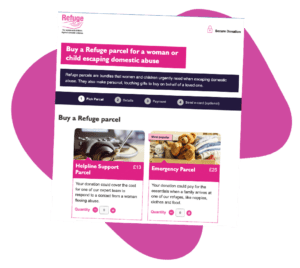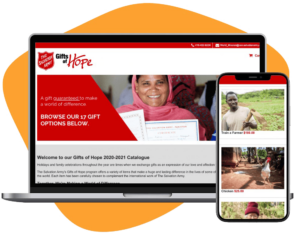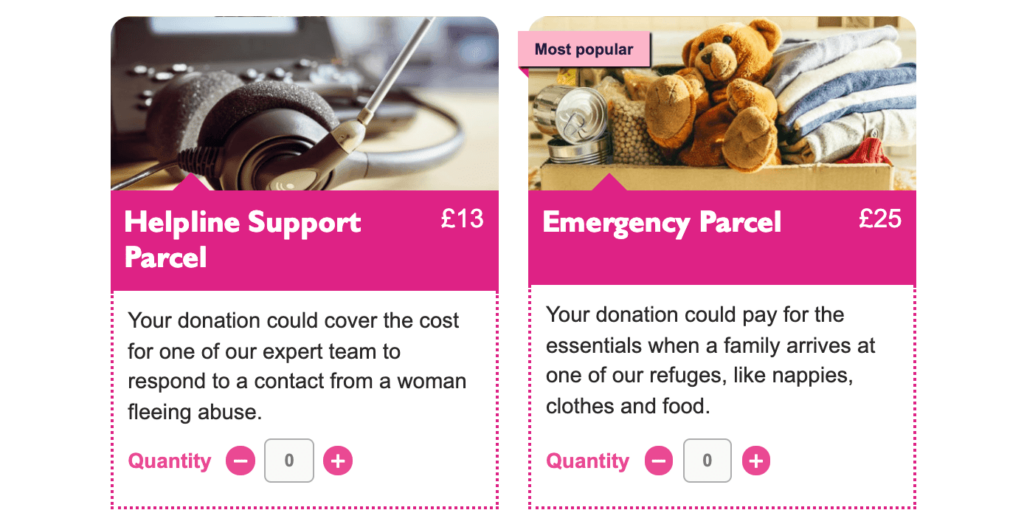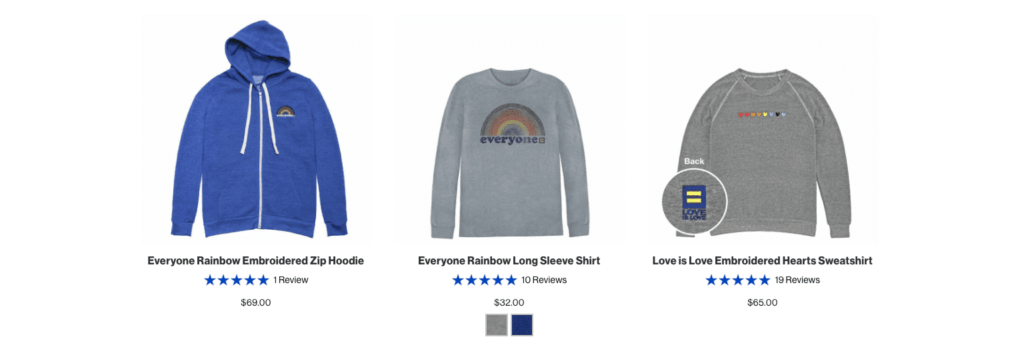Nonprofits rely on many tools to encourage supporters to give year-round – especially at the end of the year. You’re probably trying every tactic in your playbook to reach donors around the holidays when they’re feeling most generous – or are you?
Sometimes a little one-time effort, creativity and willingness to try something new can open new doors to untapped revenue. eCommerce is one example of a tool with tremendous potential that nonprofits rarely use. Join us to take a look at why, how to break down those barriers and how to bring in more money for your cause.
A caveat, this is written from my personal experience as a fundraiser in the United States. Check your local regulations for taxes and gifts to ensure you’re in compliance as it varies greatly by country.

It’s the holiday season and I’ve just finished my holiday shopping – very happy about that. As I’m writing this, I realize that while I did give to my favorite charity, I didn’t GIFT FOR any charities. Why is that?
As I’m compiling end-of-year fundraising resources for this blog, I realize I didn’t get any emails, see any eCommerce-style donation pages, or even get a premium-based email offer from a nonprofit. Now given, I’m getting a lot of email this time of year, but typically I’m looking for these things.
Why is that? Why do so few charities choose to offer items – either physical or symbolic – as part of the donation process?
Why Offer Physical or Symbolic Items in Addition to Donations
eCommerce is a passion of mine. Despite spending years doing traditional online fundraising, I get a thrill when there’s product involved. Why? It’s basic psychology on several levels.
Giving to a charity can feel akin to making a donation to Santa Claus. You’re putting your money out there because a cause you care about is doing good work but you generally have no idea how they use it or where it goes. And yes, part of your donation may be used for paperclips but I’m sure they’re necessary. Believing in a cause and having faith enough to GIVE isn’t something everyone is willing to do.
“Things are repositories for the meaning people project on them. A cross is just two pieces of wood but for what it represents to Christians.”
Julie Beck, The Atlantic
On a broad level, we’re a consumption-based society. For those in the world who may be less inclined to give for the sake of giving, offering ‘stuff’ can be a nice incentive. It bypasses some of the mystery of giving by making the donation more transactional, therefore opening doors to new potential donors. I’ve often used a premium tactic when appealing to prospective donors around the holidays with great success.
On an individual level, our attachment to items is fascinating. This Atlantic article was a great read and offers some insight into why we become – and often remain – attached to items. Seriously, please read that article.
The premise of the article is that while we seem like a wildly materialistic society – and likely are – there are ‘things’ that strike chords deep inside us. They speak to life experience, passion, memories, desires. While we can sometimes call up those feelings at will, sometimes it’s an item that reminds us.
A personal experience of item attachment
Early in my career, I was looking for my first big move. I was in South Africa in 2007 at an International Conference on Conservation Biology when I met Laurie Marker. Laurie is to cheetah conservation what Sylvia Earle is to marine biology – a brilliant, passionate, intelligent, badass woman. We hit it off immediately and shortly after she brought me on to lead all North American Operations for the Cheetah Conservation Fund (CCF).

During that time I never made it to Namibia to see the CCF facilities but I did have some amazing experiences in North America working with a truly inspiring woman and cause. I worked with cheetahs on several occasions and have a passion for them to this day. Have you ever touched a cheetah and heard it purr up close? Amazing.
One of the annual fundraisers we did was Chewbaaca’s Annual Match Challenge, one of the famed CCF cheetahs in Namibia. It was also my first dive into online fundraising where I spent much of my career. I have a picture of Chewbaaca the cheetah to this day (he’s sadly passed). I don’t know if I’d grab it on my way out of a burning house – but I keep it. It reminds me of a pivotal time in my life and career.
So why don’t we offer people passionate about our causes, experiences or items that burn that cause into their memories?
Types of Nonprofit eCommerce fundraising
Let’s touch quickly on the different types of eCommerce open to a nonprofit. You can dip your toes or dive in.
Premium gifts
Some would argue this isn’t eCommerce but let’s face it, it’s an exchange of money for goods or services. A premium gift is when someone makes a donation and they get an item or sometimes an experience. You’ve probably at least seen ‘donate and get this shirt or mug’. That’s a premium gift. You can build an entire eCommerce store with multiple premium gifts. Within certain rules.
Important note: The IRS has specific rules around premium gifts. You should consult your accounting department and perhaps legal to be 100% sure you’re in compliance. Here’s a top level summary with links to IRS resources though. More info on the IRS website.
Token gifts
A token item must fit into this criteria:
- Include your logo
- Have a market value of no more than 2% of the total donation. So if someone gives $100, the market value of the item can’t be more than $2.
- Must not be more than total $50 market value (which means the donor would be giving $2,500! Just sayin’)
Token items are tricky. You have to buy in quantity, send small gifts only, or partner with your direct mail team who is already buying hats and calendars in quantity at reduced costs.
Non-token gifts
These are gifts that don’t fit within the parameters of ‘token items’ above. If you want to offer donors a beach towel that costs $10, you still can. It’s still good brand exposure and a donation. You just need to be clear to donors what the value of their tax deductible gift is. Because it’s not a ‘token item’ you subtract the value of the item from the donation and that’s their deductible portion. At least in the United States. What does that look like?
- A donor gives $100 and opts into receiving the beach towel. That towel cost you $10 so their tax deductible portion is $90 only. You made it clear in the transaction process (transparency) that only $90 is tax deductible. And you make it clear on their receipt.
The rules: There are some other nuanced categories and if you use a premium gift do your research regardless to be sure you’re in compliance. This isn’t a definitive guide, your organization may have unique rules and IRS policies change over time. You can start here with the IRS.
Symbolic gifts

These are non-tangible gifts that make the donor feel good, as if they’ve exchanged funds for a tangible action on behalf of the organization. Think, ‘Your donation of $100 helps us feed 10 cheetahs for a month.’ The organization gives examples of the impact of a donation but there is no tangible exchange of goods or services. This is the least impact option for an eCommerce store because it’s essentially creative framing around regular donations.
Important note: You must be clear and transparent when offering symbolic gifts unless they are specifically going to a project or program. If that’s the case, they are restricted funds and donors will hold you accountable. If you’re fundraising for unrestricted donations, make note on the ‘product page’ and elsewhere that their gift is unrestricted.
An eCommerce store is easy to set up in any of these scenarios – premium gifts or symbolic gifts.
Hurdles of Nonprofit eCommerce fundraising
There are plenty of reasons why nonprofits don’t attempt eCommerce. I’m sure they think they’re all good reasons but if you take a step back and shift your perspective, there’s no reason every nonprofit shouldn’t be doing this on some level. It can result in more money for your cause.
Let’s take a look at a few things that hold organizations back…
The ‘stuff’ mentality
With years at environmental nonprofits and a mind to sustainability, this is always the first on my mind. We all have too much stuff. Should we be encouraging donors to acquire more stuff? Stuff that we need to produce, warehouse and ship which increases our carbon footprint as an organization? This is a values based question per organization but I’ve heard it many times. My thought on this is simple. If donors want to give without a transactional experience, they will. For the others, offer them a way to come in that may be more accessible – and a way to opt-out of a gift.
Flip it on its head: If this is a concern, instead of focusing on the ‘stuff’, focus on sourcing sustainable items you can offer to donors. Give them a way to opt-out of the gift or offset the footprint of the gift. Or make the gift an experience or electronic item like an eCard.
The association with direct mail
Direct mail and digital teams are often of very different minds. The truth is, we can learn a lot from eachother – but shouldn’t shut down the work of the other. It’s an ecosystem of fundraising. Offering premiums and swag is a very traditional direct mail tactic. I’ve experienced both sides of this. One moment digital would collaborate on a swag promotion very successfully making it a strong cross channel effort. And the next, I’ve had the direct mail team flat out say we can’t do digital premiums because they’ve seen (in direct mail) that the donor retention is poor. The solution to this is testing. While you’re working together and ideally feeding eachother’s efforts, no one should assume that something won’t work until you’ve tested it – in the relevant channel!
Tip: Take a look at what data is available and listen to your peers but – unless there are clear correlations pointing to failure – don’t let that hold you back. Create a plan to test your eCommerce efforts in a way that everyone can relate to and measure your results.
The barriers of traditional eCommerce

I tried several times in my career to launch an eCommerce store with symbolic and premium items and never got very far. At one job, we had gone as far as to build a strategy, coordinate with teams, schedule promotion, create the store in Shopify, list the items, do photoshoots with staff and write up the store terms. All of this only to be shut down by the Accounting team a the 11th hour over concerns that it could be misconstrued as an ‘eCommerce’ store.
Having briefly run an actual eCommerce store, I can tell you these concerns are no joke. In for-profit eCommerce goods and services, you pay federal taxes and you’re supposed to pay individual state taxes in any state you have ‘Nexus’ – AND file your company in those states. I’ll let you look up Nexus yourself if you’re interested. And there are other tax rules that are hard to follow.
Truth: As long as you stay within the parameters of the previous section for premium and/or symbolic gifts you don’t have to file for and pay eCommerce taxes. That said, be sure your accounting team is comfortable with this so you don’t run into my issue at the last minute. In the end, we were told we could run the store, we just couldn’t call it a ‘store’ or ‘eCommerce’. So give thought to internal messaging as well.
Staff capacity and technology issues
‘It would require a new technology solution.’
‘We don’t have time to set this up and fulfill the gifts.’
‘Our team is already overwhelmed.’
Those are all just concerns. Let’s touch on each.
If you’re using an integrated digital engagement platform like Engaging Networks, likely eCommerce is already baked in. Or at the very least, you can manipulate a donation form to offer premium gifts. Don’t let technology seem like a hurdle. These days, it’s rare that even an employee without coding skills can’t develop a form that offers some sort of premium – or a full store. This hurdle is often a misperception.
Tip: When adding eCommerce, consider an integrated solution like Engaging Networks. This will enable you to add this type of eCommerce donor to your email marketing flows seamlessly and continue to nurture them as regular donors.
With regards to staff time, this is a matter of priorities. If diversifying revenue streams and bringing in more donations is a priority, consider moving a less important project off your team’s plate so they can set this up. Once the store is set up, you won’t have to do much else and they can return to other work. If fulfilling ‘gifts’ is a concern, stick to symbolic giving with eCards so that your team doesn’t have to pack and ship t-shirts and hats.
Idea: We used to make it clear when we ran a premium offer that we’d ship ALL of them on one day. Then we’d order a team lunch, play holiday music or watch Elf and pack hats to ship that day. ‘Fulfillment’ doesn’t have to be painful.
How can you benefit from adding eCommerce fundraising
If you only offer supporters one way to give eventually you’ll be left in the dark… alone. To be honest, eCommerce is something nonprofits should have taken advantage of years ago. Now… we’re in the age of digital wallets and crypto currency. The point being, this is an opportunity to be taken and not left behind. And soon. Why?
Additional revenue source

Someone once told me ‘meet them where they are’. It was some of the best advice I’ve ever received. We should never assume our way is someone else’s way and this becomes more and more evident as time goes on. By offering supporters multiple ways to give like a standard donation form, peer-to-peer and eCommerce to name a few, you’re diversifying your revenue opportunities. You’re meeting supporters where they are and giving them more than one way to show their support. You may just find that one regular donor also likes to do a birthday fundraiser and give eCommerce gifts to loved ones at the holidays.
Upsell opportunities
I have a love/hate relationship with upsells. A GOOD upsell gets me everytime (don’t you hate that?). With a standard donation form, upsells are limited. In most eCommerce platforms like Engaging Networks, you can suggest similar products and even ask for an additional donation before checkout. What would be a standard $50 donation on a regular form becomes a $50 symbolic gift with an add-on donation. Upsell.
Brand exposure
Token items have a useful requirement – your logo. eCommerce has the ability to spread your brand and raise awareness through your supporters. This can be through token premiums or symbolic gifts. When you supporters give a gift to others they’re not only expanding your reach, they’re acting as ambassadors for your cause. This type of endorsement builds instant credibility with new prospective supporters.
The Reality of Nonprofit eCommerce
It doesn’t have to be that hard. Now that you know the options – and hopefully are using a great integrated digital engagement platform like Engaging Networks that offers eCommerce – setting this up for your organization can be relatively painless. Check out this case study showing how UNHCR Canada utilizes our eCommerce module.
Here are a few good examples of nonprofits doing eCommerce and why I like them (personally):
#1 – Action for Children UK – First of all I like the design of this page and how it feels child-like but not childish – you remember you’re helping children. But most of all, I like how they offer the option to give your gift monthly and not just once!

#2 – International Medical Corps – They did a lovely job of giving the shop a holiday feel and selected images that convey both urgency and happiness at the same time – a very difficult thing to do.

#3 – Salvation Army Canada – Check out the clever use of pop-ups as you scroll over the ‘products’! It’s an easy way for supporters to fill their cart quickly.

#4 – Refuge UK – I love how Refuge frames the gifts as ‘parcels’. “Refuge parcels are bundles that women and children urgently need when escaping domestic abuse.” This is a perfect example of how a symbolic gift can be urgent, compelling and strong.

#5 – Human Rights Campaign – Now, I’m not sure if they fit into the token premium rules or are running a real eCommerce store but… you should check out their compelling cause related products as good examples of how you can use eCommerce to broaden your reach. In fact… I just bought a hat. AND made a donation in honor of all my friends and family who are LGBTQ+ – happy holidays!

How can you get started with eCommerce?
If you’re not using eCommerce and you don’t have the tools you need, Engaging Networks can help. Learn more about our eCommerce module here or read in our Supportal how to get it off the ground. Good luck to you!